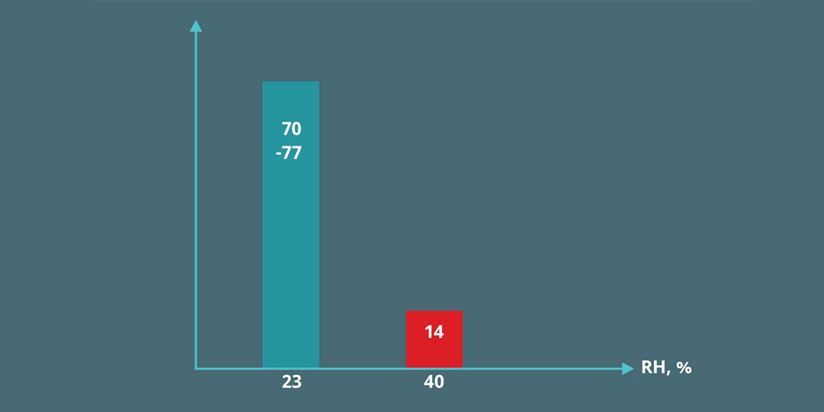Virus is more contagious in dry air. This is why:
Right now, many people are searching for ways to limit the spread of virus infection - and outlandish ideas are being batted around on the Internet, ranging from spraying disinfectants over people to high alcohol consumption.
There is no scientific evidence for many of these highly creative solutions to the challenge of virus infection, and Airtec® does not recommend any of these.
What we do recommend is to remain calm and to rely on what we actually know to be scientifically proven: That humidity control can, in fact, reduce the risk of infection.
Facts: What we know about infection risk and humidity?
Overall, the risk of virus infection is significantly reduced if the humidity is kept under control and above a minimum level.
In a 2013 study at the US Center for Disease Control and Prevention (CDC), researchers investigated how humidity affects the risk of being infected with the flu virus. The experiment was performed with a number of machines that could simulate both coughing and inhalation in humans, allowing the spread of infection from the "coughing" machines to be measured. Special emphasis was placed on testing infectious viruses that may affect humans, such as influenza viruses.
The study showed that up to 77% of infectious influenza viruses could still be infectious after one hour - as long as the humidity was at 23% RH or below. By contrast, if the humidity was raised to 40% or more, the infectivity dropped dramatically, leaving only 14% infectious viruses left in the room's air.
It was also found that the higher humidity also made the influenza virus inactive after a short time - after only 15 minutes there was virtually no infectivity left.

This chart shows the percentage of infective flu virus 1 hour after release in relation to RH.
This phenomenon is one of the reasons influenza viruses hit us harder during the winter months. In summer, the typical relative humidity indoors is usually between 30 and 40%, which is close to the area where influenza viruses no longer have the ability to infect humans. But when we heat our offices and homes in the winter, relative humidity drops significantly - providing far better conditions for the flu virus.
Why air humidifiers are effective against the spread of virus
New studies show that higher humidity increases the resistance to viruses, e.g. by strengthening the immune system's defense against the signaling proteins a virus needs to infect its host. At the same time, it is also known that many types of viruses, e.g. influenza, die at temperatures above 30° C and at a relative humidity above 40-50%. A humidifying system supplies water to the air in the form of a water mist and is furthermore fitted with a control system that precisely supplies the amount of water that an office space or production hall requires, keeping the humidity within a narrow range regardless of climatic conditions outside.
At Airtec®, we are happy to advise on the technical possibilities available for installing and regulating air humidifying systems in any type of building. On our website you can also read about several different air humidification solutions that can help improve indoor climate control.
Sources
https://www.sciencedaily.com/releases/2013/02/130227183456.htm
https://news.yale.edu/2019/05/13/flu-virus-best-friend-low-humidity
https://pubs.acs.org/doi/full/10.1021/es1016153